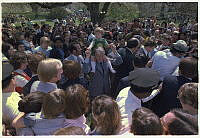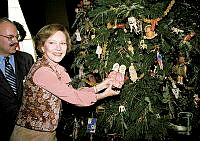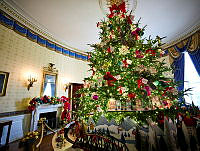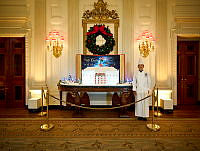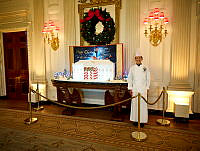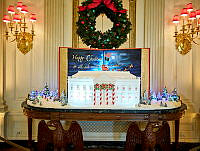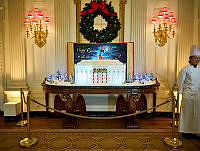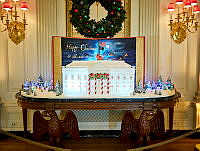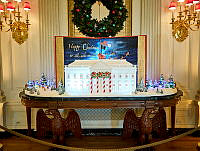Rubenstein Center Scholarship
Demon Cat
The Tale of a Wanderlust Feline Ghost
The “Demon Cat” apparition is one of the best-known ghost stories in Washington, D.C. It refers to an oversized, menacing cat that appears sporadically in prominent federal government buildings. According to the legend, the Demon Cat conspires to frighten unsuspecting people. Other times, the Demon Cat’s appearance has been considered a prophecy of impending disaster or tragedy. The Demon Cat is also sometimes known as simply “D.C.”
According to an 1898 article in the Washington Post, the Demon Cat appears as a regular-sized housecat initially but then quickly expands to the “size of an elephant before the eyes of a terrified observer.” The first recorded appearance of the Demon Cat was in the United States Capitol in 1862. During the Civil War, the U.S. Capitol’s basement was used as a bakery to feed soldiers, and the Demon Cat appeared there several times. A guard reportedly fired a gun at the cat, and it disappeared. Since its initial manifestation, the Demon Cat most frequently shows up in the basement of the Capitol Building.1 The cat is sometimes described as a tabby, although others who have claimed to have seen it believe it is black.

The Demon Cat is sometimes described as an average tabby, which grows to an enormous size to scare its victims.
Library of CongressIn a 1935 account published in the Washington Post, one observer remarked that the Demon Cat’s eyes “glow with the all the hue and ferocity of the headlights of a fire engine.” The article also hints at a practical explanation for the Demon Cat: many cats ran freely in the basement passageways of the U.S. Capitol for decades, serving as cost-free and efficient exterminators of mice and vermin.2 Former congressman John Dingell lends support to this detail, as he recalled hunting rats that were “as big as housecats” in the basement of the Capitol Building as a House of Representatives page during World War II.3
Like most ghost stories, there are numerous variations of Demon Cat stories.4 One of the most unique aspects of the Demon Cat legend is that the feline ghost appears at more than one location. The myth extends from the Capitol Building to the White House. When the Demon Cat appears on the Ground Floor of the White House, considered previously as the basement, the apparition foreshadows a terrible event. As the tale goes, a White House guard witnessed the Demon Cat just before the stock market crash in 1929. Allegedly, another White House nightwatchman spotted the Demon Cat prior to John F. Kennedy’s assassination in 1963.5 Although the Demon Cat’s appearances at the White House cannot be confirmed by a firsthand source, the feline apparition is occasionally listed as one of the “most famous” ghosts of the Executive Mansion.6

According to legend, the Demon Cat appears at the United States Capitol and the White House.
White House Historical Association (Adapted using images from the New York Public Library and Library of Congress)Why does the myth of the Demon Cat persist over time, and why does it span more than one location? The legend of the Demon Cat has benefited from the oral tradition of ghost stories, which date back to Shakespearean Renaissance England. Fireside tales served as a reliable source of entertainment, particularly in rural areas. Even as the robust oral tradition of the ghost story waned in the early 1800s, due to increased human mobility and urbanization, the practice of sharing ghost stories by word of mouth persists today.7 The Demon Cat benefits from this oral tradition, which allows the story’s details to evolve over time, including the location of where the feline specter appears. The Demon Cat may have relocated from the United States Capitol to the White House in an effort to further perpetuate the story and make it seem more credible. Also, given that the White House has so many ghost stories attached to it already, it seems plausible that the Demon Cat might eventually turn up at 1600 Pennsylvania Avenue.
Another possible explanation is the potential influence of Tige (also known as Tiger), a wandering cat of considerable renown owned by President Calvin Coolidge and First Lady Grace Coolidge. Tige lived at the White House, but liked to visit other federal buildings upon occasion, oftentimes disappearing for days at a time. When Tige absconded, it was reported widely in the news, garnering a considerable amount of attention for his vanishing act.8 Tige’s wanderlust may have contributed to the belief that the Demon Cat occasionally switched locations.

Tige, the cat owned by the Coolidges, is pictured here with the guard in 1924 who found him at the Navy Building.
Library of CongressAccording to United States Capitol Historical Society public historian Steve Livengood, the concept of the Demon Cat likely originated with a guardsman at the United States Capitol who may have imbibed a little too much during a long nighttime stretch. After sleeping off the bender, he likely awoke to a basement mouser cat, who appeared larger than life since the guard was lying down. Livengood even surmised that the watchman’s story could have perpetuated itself because a Demon Cat sighting likely resulted in a day off work.9 The oral tradition of ghost stories substantiates Livengood’s explanation, since those who worked graveyard shifts in the lonely bowels of the Capitol and White House may have traded stories about what they saw and witnessed.
Practical explanations aside, the Demon Cat legend also makes logical sense from a folklore perspective. In many different cultures and countries, cats are viewed as powerful mystical creatures whose presence communicates bad omens.10 Cats are also nocturnal animals, associated with nighttime prowling and witchcraft.11 The United States Capitol and the White House are the most famous, and allegedly most haunted, buildings in Washington, D.C. In that sense, the Demon Cat myth remains as one of the most well-known ghost stories in the nation’s capital because it is a perfect blend of history, creative storytelling, and widely shared superstition.













